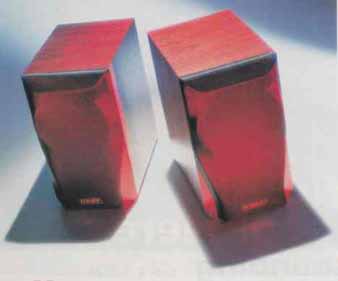
Mission is a British manufacturer of high-performance loudspeakers, which are among the top sellers in the company’s native land; for nearly a year, now, they have been distributed in the U.S. by Denon. The 750 Limited Edition (LE) mini-monitor is at the bottom of the company’s upscale 75 Series. Despite its moderate price, it is not a stripped-down model made for the cost-conscious but, as company founder Farad Azima says, “a celebration speaker” to mark Mission’s 20th anniversary last year. Azima calls the 750LE “a product central to the very core of Mission’s philosophy—a blend of leading-edge technology and impeccable aesthetics but with that extra something that animates the very soul of music,” adding that “Above all we wanted our celebration speaker to be modestly priced, to include. . .our customers whose investment in our products and constant encouragement have sustained us from the beginning.” The 750LE appears to be all of this and more.
The Mission 750LE is a small, two-way system with a 5¼-inch woofer and a 1-inch fabric-dome tweeter, both developed specifically for this speaker. The enclosure is vented to the rear via a molded plastic tube with a flared mouth; the tube has an inner diameter of 1¼ inches and is 2¾ inches long. Real wood veneer covers the cabinet’s top, sides, and much of its front panel. Except where the top meets the sides, all edges are either rounded or beveled.
- -- - - - SPECS -- - -- --
Rated Frequency Response: 70 Hz to 20 kHz, ±3 dB.
Rated Sensitivity: 86 dB at t meter, 2.83 V rms applied.
Rated Nominal Impedance: 6 ohms. Recommended Amplifier Power: 30 to 100 watts.
Dimensions: 11 in. H x 6½ in. W x 10¾ in. D (28.0 cm x 16.5 cm x 26.2 cm).
Weight: 9.4 lbs. (4.25 kg) each. Price: $500 per pair, in rosewood veneer or black.
Company Address: Mission, c/o Denon Electronics, 222 New Road, Parsippany, N.J. 07054; 973/575-7810
- --- - - -
Mission made heavy use of computer- aided solid modeling techniques to design a rigid cabinet that it says is self-braced and self-damped. The cabinet panels form two U-sections that interlock to form the complete cabinet. Tolerances are said to be so close that joints are virtually airtight even before the cabinet is bonded. The top and side walls are made from an uncommonly thick, 1¼-inch, medium-density fiberboard (MDF), into which swirling grooves have been machined. The machining lowers the panels’ mass (to reduce stored energy) and increases the cabinet’s internal volume but doesn’t significantly reduce the thick panels’ inherent rigidity. The groove pattern is also said to disperse internal reflections and reduce the effect of standing waves. The front, back, and bottom of the cabinet are made from MDF in a more conventional, ¾-inch, thickness.
Most of the front panel is covered by a molded plastic plate whose surfaces are smooth and rounded, to reduce diffraction. Instead of being attached to the cabinet front panel, as the woofer is, the tweeter is attached to the molded plate, to mechanically decouple it from the woofer. The 750LE’s grille, of molded plastic covered with black cloth, snaps into rubber-grommeted holes in the front plate.
The 750LE’s woofer has a molded plastic frame, a ferrite magnet 2¾ inches in diameter and 0.6 inch thick, and a cone made from Aerogel, a patented material composed of short strands of carbon fiber and Kevlar suspended in an acrylic polymer gel.
According to Robin Marshall, the 750LE’s designer and engineer, Aerogel is 50% more rigid than average paper cones yet has 75% less mass, giving it an extremely high stiffness-to-mass ratio. Marshall also states that it has a high internal loss factor, which damps surface resonances and helps prevent energy storage.
The woofer’s cone is attached to the frame with a rubber surround. Instead of a dust cap moving with the cone, there’s a stationary phase plug around which the cone and voice coil move. This is said to further lower cone mass and to improve off-axis phase characteristics.
The 750LE’s tweeter is a 1-inch, coated- fabric dome driven by a powerful neodymium magnet. A star-shaped molded plastic clamp assembly holds it to the molded front plate.
The crossover is wired point-to-point on the back of the input connection cup, on the rear panel. The low-pass section is a first-order series-inductor design with a resistor-capacitor (RC) impedance-compensation network across the woofer. The high- pass is a second-order filter consisting of an RC network in series with the tweeter and an inductor in parallel with it. The woofer’s inductor has a powdered-iron core, the tweeter’s an air core. All parts are of high quality.
The bi-wirable terminals are heavy-duty gold-plated binding posts. Although the posts are spaced the standard 34 inch apart, you cannot insert double (or even single) banana plugs without prying out small plastic plugs that close off the posts’ end holes. The plugs are required by European safety regulations, because some European AC power plugs are similar to double banana plugs.
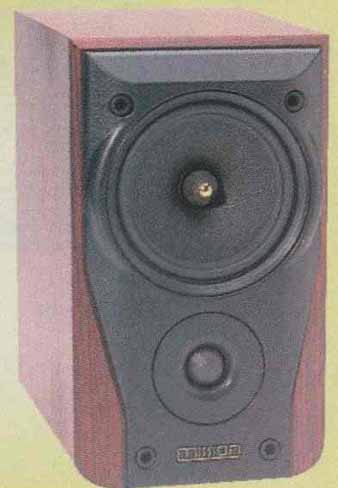
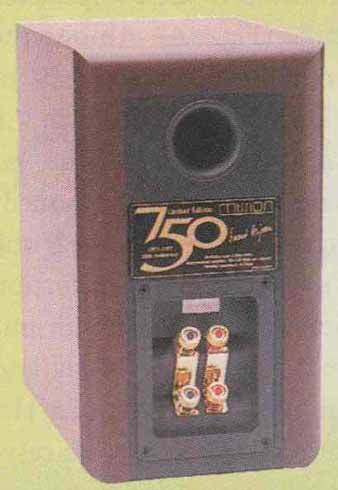
The Mission 750LE is a ported, iwo-way speaker with gold-plated
bi-wirable
input terminals.
Measurements
The Mission 750LE’s frequency response curve (Fig. 1) with its grille off fits a fairly tight, 4.7-dB, window from 87 Hz to 20 kHz. Enlarging the window to 6 dB extends the lower frequency limit to 80 Hz, quite close to Mission’s rated frequency response. However, the curve is somewhat uneven, exhibiting peaks at 125 Hz, 1.45 kHz, and 12.5 kHz and dips at 230 Hz, 700 Hz, 6 kHz, and 15.5 kHz. Averaged from 250 Hz to 4 kHz, the 750LE’s sensitivity measured a moderate 84.4 dB. The grille causes a +2-, —3-dB ripple between 3 and 4 kHz and reduces overall level by about 1 to 1.5 dB above 7 kHz. The two speakers matched within a very close ±0.5 dB. (The curves in Fig. 1 combine ground-plane bass measurements and measurements taken in a large anechoic chamber, and the “Grille Off” curve was smoothed. The test microphone was midway between the two drivers’ axes.)
When the tweeter and woofer sections of the crossover were driven directly through their separate 70 input terminals, the two drivers’ acoustic outputs crossed at about 60 2.45 kHz, the apparent crossover point. The measurements also indicated that the woofer rolled off at 12 dB per octave above 2 kHz, while the tweeter rolled off at 6 dB per octave below about 4 kHz. Experimentally reversing the signal polarity to one driver produced an octave-wide rejection dip of about 15 dB between about 2 and 4 kHz. This demonstrates that, when the sections are connected normally, the drivers’ outputs are pretty much in phase acoustically through the crossover region and lobing should be minimal.
When a direct-radiator speaker’s drivers share a common surface, the low-frequency drivers are usually delayed behind the high-frequency drivers, and the 750LE’s phase and group-delay responses (Fig. 2) show such a delay. The phase continually falls as frequency increases, while the group-delay curve has an offset of about 0.25 millisecond between about 300 Hz and 2 kHz. This measured delay is due partly to physical offset between the two drivers and partly to delay inherent in the crossover that drives the woofer.
The 750LE’s horizontal off-axis responses (Fig. 3) are extremely uniform all the way to 20 kHz within the main, ± 15°, listening window. Farther off axis, the response narrows above 13 kHz.
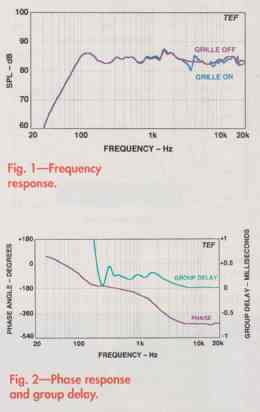
Fig. 1—Frequency response. The Mission 750LE is a ported, two-way speaker
with gold-plated bi-wirable input terminals.
Fig. 2—Phase response and group delay.
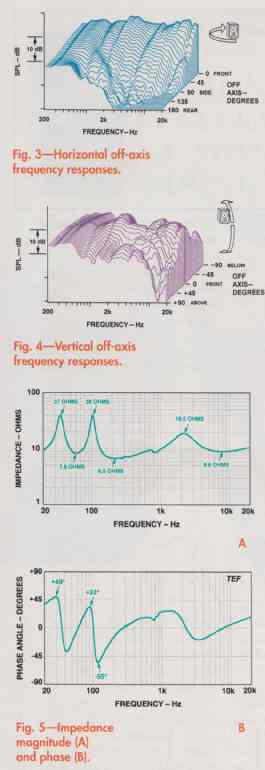
Fig. 3—Horizontal off-axis frequency responses.
Fig. 4—Vertical off-axis frequency responses.
Fig. 5—Impedance magnitude (A) and phase (B).
The 750LE’s vertical on- and off-axis responses (Fig. 4) are fairly uniform except in the crossover region, between 2 and 4 kHz. In the main listening window, ±15°, the responses are quite uniform. Farther off, be tween 300 and 45° above and below the axis, a deep null develops between 2 and 4 kHz (not clearly visible in the graph).
The Mission 750LE’s impedance magnitude (Fig. 5A) exhibits the classic dual-peak characteristic of vented enclosures. The dip to 7.8 ohms at 60 Hz indicates the approximate location of the vented- box tuning frequency, where the woofer’s excursion and distortion is minimized. The maximum impedance is 38 ohms, at 105 Hz, and the minimum occurs at 225 Hz, where impedance drops to an easy- to-drive 6.5 ohms. Mission is being a bit hard on the 750LE by calling it a 6-ohm speaker; judging from the overall curve, it could honestly be rated at 8 ohms. Between 20 Hz and 20 kHz, the impedance range is a moderate 5.8 to 1 (38 divided by 6.5). Cable series resistance can therefore be as high as 0.09 ohm without cable-drop effects causing response peaks or dips greater than 0.1 dB. For a typical run of about 10 feet, that would correspond to 16 gauge (or heavier), low-inductance cable. The impedance phase (Fig. 5B) reaches a moderate maxi mum of +33° (inductive), at 90 Hz, and a minimum of —55° (capacitive), at 120 Hz. The 750LE should be an easy load for any amplifier, and you can even safely connect two of them in parallel to the same amp output.
A high-level sine-wave sweep revealed that the cabinet was quite rigid, although its sides did vibrate at 315 Hz, causing a slight buzz. The 5¼-inch woofers are capable of about 0.38-inch peak-to-peak excursion and overload gracefully. Excursion reached its minimum at about 63 Hz (another guide to the vented enclosure’s resonant frequency), and no dynamic-offset distortion was evident.
I measured the 750LE’s raw and smoothed 3-meter room response (Fig. 6) with the test microphone at ear height (36 inches) and the speaker aimed at it from a 30-inch stand. Above 750 Hz, the smoothed curve fits a tight, 4.8-dB, window. Except for a 145-Hz peak and 630-Hz dip, the smoothed curve fits a fairly tight, 13-dB, window. Below 750 Hz, where room effects predominate, several large peaks and dips are evident. This is not a fault of the speaker, but shows how the room would affect any small acoustic source in the same place.
The 750LE’s B (61.7-Hz) harmonic distortion is shown in Fig. 7. I choose the higher frequency B tone rather than my usual E (41.2-Hz) tone, because E is significantly below the 750’s rated operating range and also below the vented enclosure’s tuning frequency, too low for the speaker to handle much power. At a maximum power of 50 watts (17.3 volts rms into the rated 6- ohm load), the second harmonic rose to a moderate 12.7%, while the third rose only to 5.6%. Higher harmonics were 1.9% or lower. At 61.7 Hz, a 50-watt input to the 750LE generated a quite usable 93 dB SPL at 1 meter in a free field.
The A, (110-Hz) harmonic distortion (Fig. 8) consisted only of a low, 2%, second harmonic, 2.1% third, 3.2% fourth, and higher harmonics less than 1%. At 110 Hz, a 50-watt input drove the 750LE to a fairly loud 103 dB SPL at 1 meter in a free field.
The Mission’s IM distortion for a 50- watt signal was a moderate 9.3% that was, nonetheless, clearly audible at this power level. The test signal consisted of 440-Hz (A and 61.7-Hz (B tones of equal power; once again, I substituted the B tone for my usual E because of the 750LE’s low-frequency restrictions.
The 750LE’s short-term peak power in put and output are shown in Fig. 9. The peak input power starts out quite low, at about 2.5 watts at 20 Hz, but above 30 Hz it rises quickly, reaching a plateau of 125 watts between 60 and 120 Hz. After a rise to 800 watts at 250 Hz, the peak power falls somewhat to 300 watts at 700 Hz, then rises quickly to a very high 8 kilowatts in the tweeter’s range, above 2 kHz. ‘Why did the tweeter handle much higher power than the woofer? The woofer’s peak power handling above 150 Hz seemed to be limited by inductor saturation in the woofer leg of the crossover. I did not bypass the crossover inductor as I sometimes do, but I inferred the saturation from the pointed waveshapes of the woofer’s acoustic output when it was overdriven.

Fig. 6—Three-meter room response.
Fig. 7—Harmonic distortion for 81 (61.7 Hz).
Fig. 8—Harmonic distortion for A (110 Hz).
Fig. 9—Maximum peak input power and sound output.
With room gain, the peak acoustic output starts at an unusable 70 dB at 30 Hz but rises rapidly through 100 dB at 60 Hz and 110 dB at 130 Hz. The output decreases somewhat to 108 dB at 700 Hz, then rises steeply to a loud 122 dB above 2 kHz. The 750LE’s bass out put is average for a speaker of its size and driver complement.
Use and Listening Tests
As I’ve said before, it’s a pleasure to evaluate a small speaker once in a while, and the Mission 750LE mini-monitor is quite diminutive compared to the tower speakers I usually review. That makes it easier to move around, set up, and measure, although, naturally, you lose the deep-bass power of which larger speakers normally are capable.
When I first unpacked the Missions, I was so impressed with their looks that I showed them off to everyone around. Every detail looked quite impeccable. The rose- wood finish blended very well with the molded plastic front plate. The woofer looked quite exotic, thanks to its polished, brass-colored central phase plug and the iridescent, crystalline appearance of its Aero gel cone. The smoothed and beveled surfaces of the cabinet and faceplate lent a quite pleasing quality to the 750LE.
Mission’s instruction manual, which covers the whole 75 Series, is jam-packed with useful information, including a three-page mini- dictionary of speaker terms. (Although detailed and informative, the dictionary has a decidedly high-end orientation and includes a considerable dose of Mission promotion.)
The manual suggests placing the speakers 5 to 8 feet apart, spaced 8 inches away from the wall behind them and a minimum of 1.5 feet from the side walls, and that the speakers should be aimed straight ahead, not canted in. I followed these recommendations in most respects but placed the Missions more than 8 inches from the wall, closer to where I usually put speakers. I put the 75OLEs on stands, which raised them so that each one’s bottom was just about even with the top of the comparison B&W 801’s woofer enclosure. The high frequencies sounded most natural to me with the 750s canted in slightly, not aimed straight ahead. I also broke the speakers in overnight, as the manual suggests, before I did my serious listening. To do this, I fed them a low- passed feed of pink noise from a CD, adjusting the level to provide a healthy excursion of the 750’s woofer.
All of my listening was done with standard single-cable connections. Ancillary gear included an Onkyo CD player, Krell KRC preamp, Crown Macro Reference power amplifier, Straight Wire Maestro cabling, and B&W 801 Matrix Series 3s as reference speakers. For some of my listening, I used a Velodyne HGS-12 subwoofer (June 1998) with the Missions; I fed the 75OLEs through a high-pass filter for some of my later trials, but at first I used no filter, so both the Missions and the sub reproduced frequencies below 80 Hz.
From the first, the Mission 750LE sounded balanced, smooth, and even, but with the attenuated low bass you’d expect from a speaker its size. Imaging, soundstaging, and center-channel stability were excellent. The Mission’s high-frequency extension, clarity, and balance were a pretty close match to the B&W’s. The Missions could be played loudly but were not quite as clean as the B&Ws at the same level, particularly with recordings that had any appreciable bass content. Played at more moderate levels (i.e., not at levels that had my wife saying “turn that thing down!”), the 750LEs’ balance of low and high frequencies was surprisingly good. A couple of times I even thought the subwoofer was operating when it was not.
On the low-frequency third-octave band-limited pink noise test, the 750LEs generated no usable output in the bands from 20 to 40 Hz, some usable output at 50 Hz, and stronger output from 60 Hz up. At 40 Hz and above, wind noise from the port was quite audible at my listening position, adding an irritating buzz. The noise appeared to stem from turbulence at the end of the port tube inside the enclosure. Plugging the vent with a small washcloth eliminated the buzz but reduced bass output and increased distortion from the woofer cone. However, I could hear the wind noise on al most none of the music I played, even when I was listening for it; most recordings with bass, unlike my narrow-band test signals, have significant upper-frequency energy that masks the noise.
When I played wide-band pink noise, I could hear hardly any upper-midrange tonal changes when I stood up, which is very good. The 750LE’s performance just about equaled the B&W 801’s nearly perfect behavior on this test. Its spectral balance on pink noise was quite good, albeit with some midrange and treble tonality. The 750’s voicing was quite similar to the 801’s, but with slightly more energy at the very highest frequencies.
Big-band recordings, as long as they did not contain heavy bass, sounded well balanced even when played loud. The Mission speakers handled the horn sections cleanly and with much expression. At the highest volume levels they did, however, sound slightly more congested than the B&Ws.
The Missions really shined on choral music. When I played Mozart’s Mass in C Major, K257, performed by the Kings College Choir (Argo 421 365, a favorite of mine), the cathedral soundstage was wide and expansive, while the individual choral sections were clearly delineated. The overall sound was quite involving. On well-recorded female vocalists, the 750LEs sounded quite effortless and clean, with no undue sibilance. The center image and its spectral stability were first-rate.
The speakers could play loud rock and country, but not when accompanied with heavy bass, where IM intruded on the presentation. However, when I hooked up the 750s via the Velodyne subwoofer’s high- pass filtering, all my reservations were put to rest. With the bass off-loaded to the subwoofer, the Missions could play loud and clean. At more moderate levels, the Missions could play this material very well without subwoofer assistance, sounding quite well balanced but, as you’d expect, without gut-thumping bass.
The Mission 750LEs provided high-end and near-high-end sonic performance on almost everything I listened to. Their very small size and admirable appearance make them first-rate choices anywhere high-quality sound, good looks, and modest cost are important. A pair of 750s coupled with one of the new small, high-output subwoofers, such as the Velodyne or Sunfire, can provide very high performance from a listening system that takes up hardly any space at all.
Adapted from 1998 Audio magazine article. Classic Audio and Audio Engineering magazine issues are available for free download at the Internet Archive (archive.org, aka The Wayback Machine)